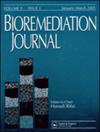Bioaugmentation of halophilic consortium for degradation of 1,4 dioxane (1,4-DE) and treatment of cosmetic industrial wastewater in continuous stirred tank reactor under saline condition
IF 1.9
4区 环境科学与生态学
Q3 ENVIRONMENTAL SCIENCES
引用次数: 0
Abstract
The heterocyclic ether 1,4-Dioxane (1,4-DE) is a toxic by-product used widely in various industrial activities as a solvent or stabilizer. 1,4-DE was classified as a probable human carcinogen accor...在盐水条件下的连续搅拌罐反应器中利用嗜卤菌联合体的生物增强作用降解 1,4 二恶烷(1,4-DE)和处理化妆品工业废水
杂环醚 1,4-二恶烷(1,4-DE)是一种有毒的副产品,在各种工业活动中被广泛用作溶剂或稳定剂。1,4-DE被归类为可能的人类致癌物。
本文章由计算机程序翻译,如有差异,请以英文原文为准。
求助全文
约1分钟内获得全文
求助全文
来源期刊

Bioremediation Journal
ENVIRONMENTAL SCIENCES-
CiteScore
5.30
自引率
0.00%
发文量
36
审稿时长
9 months
期刊介绍:
Bioremediation Journal is a peer-reviewed quarterly that publishes current, original laboratory and field research in bioremediation, the use of biological and supporting physical treatments to treat contaminated soil and groundwater. The journal rapidly disseminates new information on emerging and maturing bioremediation technologies and integrates scientific research and engineering practices. The authors, editors, and readers are scientists, field engineers, site remediation managers, and regulatory experts from the academic, industrial, and government sectors worldwide.
High-quality, original articles make up the primary content. Other contributions are technical notes, short communications, and occasional invited review articles.
 求助内容:
求助内容: 应助结果提醒方式:
应助结果提醒方式:


